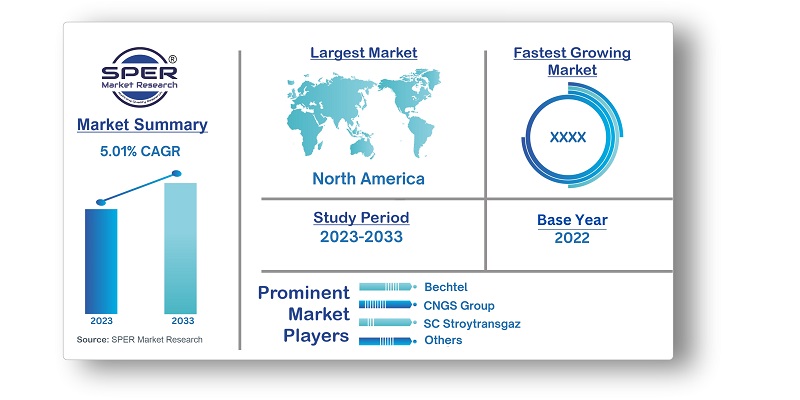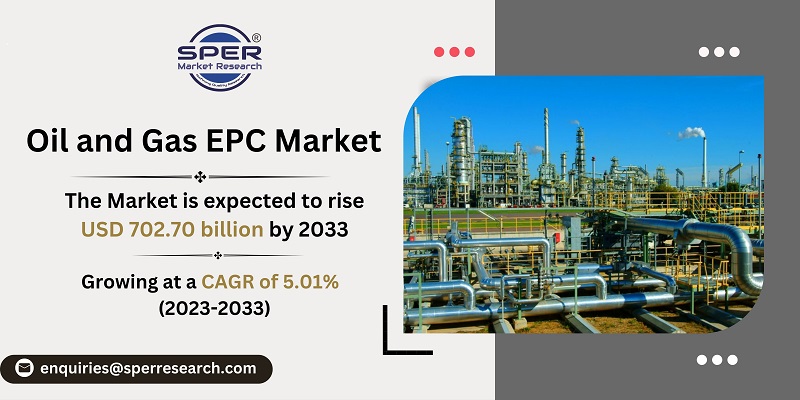
Oil and Gas EPC Market Growth, Trends, Size, Revenue, Scope, Challenges and Future Competition
Oil and Gas EPC Market Size- By Service Type, By Application, By End User- Regional Outlook, Competitive Strategies and Segment Forecast to 2033
| Published: Jul-2023 | Report ID: POAE2344 | Pages: 1 - 237 | Formats*: |
| Category : Power & Energy | |||
- Technological advancements: The oil and gas industry is constantly evolving with the advancement of technology. New technologies such as hydraulic fracturing (fracking), deepwater drilling, and enhanced oil recovery techniques have expanded the potential for oil and gas production. The implementation of these technologies often requires the expertise of EPC companies to design and construct specialized facilities, boosting the market growth.
- July 2022- Saipem SpA secured multiple offshore and onshore contracts worth around US dollars 1.25 billion in the Middle East. In the first set of agreements, onshore drilling contracts worth around USD 600 million in the Middle East are extended. The EPC and installation of multiple offshore jackets, decks, subsea pipelines, subsea composite cables, optic cables, and brownfield improvements are included in another four new contracts in the area. These contracts are worth a total of USD 650 million.


| Report Metric | Details |
| Market size available for years | 2019-2033 |
| Base year considered | 2022 |
| Forecast period | 2023-2033 |
| Segments covered | By Service Type, By Application, By End-User |
| Regions covered | Asia Pacific, Europe, Middle East and Africa, North America, Latin America |
| Companies Covered | Bechtel, CNGS Group, Daewoo Engineering & Construction Co. Ltd., Fluor Corporation, HEXA, Hyundai Engineering & Construction (Hyundai E&C), Jacobs Engineering Group Inc., JSC Stroytransgaz, KBR Inc., L&T Hydrocarbon Engineering, McDermott International Inc., Mott MacDonald, National Petroleum Construction Company, Petrofac, Saipem S.p.A., Samsung Engineering Co. Ltd., TechnipFMC PLC, WorleyParsons, Others |
- Consulting and Engineering Firms
- Equipment Manufacturers and Suppliers
- Financial Institutions and Investors
- Government Agencies and Regulatory Bodies
- Independent Oil and Gas Operators
- International Organizations and Agencies
- National Oil Companies (NOCs)
- Oil and Gas Companies
| By Service Type : |
|
| By Application : |
|
| By End-User : |
|
- Global Oil and Gas EPC Market Size (FY’2023-FY’2033)
- Overview of Global Oil and Gas EPC Market
- Segmentation of Global Oil and Gas EPC Market By Service Type (Construction & Installation, Engineering, Fabrication & Equipment, Management Services, Procurement)
- Segmentation of Global Oil and Gas EPC Market By Application (Offshore, Onshore)
- Segmentation of Global Oil and Gas EPC Market By End User (Downstream, Midstream, Upstream)
- Statistical Snap of Global Oil and Gas EPC Market
- Expansion Analysis of Global Oil and Gas EPC Market
- Problems and Obstacles in Global Oil and Gas EPC Market
- Competitive Landscape in the Global Oil and Gas EPC Market
- Impact of COVID-19 and Demonetization on Global Oil and Gas EPC Market
- Details on Current Investment in Global Oil and Gas EPC Market
- Competitive Analysis of Global Oil and Gas EPC Market
- Prominent Players in the Global Oil and Gas EPC Market
- SWOT Analysis of Global Oil and Gas EPC Market
- Global Oil and Gas EPC Market Future Outlook and Projections (FY’2023-FY’2033)
- Recommendations from Analyst
1.1. Scope of the report1.2. Market segment analysis
2.1. Research data source2.1.1. Secondary Data2.1.2. Primary Data2.1.3. SPER’s internal database2.1.4. Premium insight from KOL’s2.2. Market size estimation2.2.1. Top-down and Bottom-up approach2.3. Data triangulation
4.1. Driver, Restraint, Opportunity and Challenges analysis4.1.1. Drivers4.1.2. Restraints4.1.3. Opportunities4.1.4. Challenges4.2. COVID-19 Impacts of the Global Oil and Gas EPC Market
5.1. SWOT Analysis5.1.1. Strengths5.1.2. Weaknesses5.1.3. Opportunities5.1.4. Threats5.2. PESTEL Analysis5.2.1. Political Landscape5.2.2. Economic Landscape5.2.3. Social Landscape5.2.4. Technological Landscape5.2.5. Environmental Landscape5.2.6. Legal Landscape5.3. PORTER’s Five Forces5.3.1. Bargaining power of suppliers5.3.2. Bargaining power of buyers5.3.3. Threat of Substitute5.3.4. Threat of new entrant5.3.5. Competitive rivalry5.4. Heat Map Analysis
6.1. Global Oil and Gas EPC Market Manufacturing Base Distribution, Sales Area, Product Type6.2. Mergers & Acquisitions, Partnerships, Product Launch, and Collaboration in Global Oil and Gas EPC Market
7.1. Global Oil and Gas EPC Market Value Share and Forecast, By Service Type, 2023-20337.2. Construction & Installation7.3. Engineering7.4. Fabrication & Equipment7.5. Management Services7.6. Procurement
8.1. Global Oil and Gas EPC Market Value Share and Forecast, By Application, 2023-20338.2. Offshore8.3. Onshore
9.1. Global Oil and Gas EPC Market Value Share and Forecast, By End-User, 2023-20339.2. Downstream9.3. Midstream9.4. Upstream
10.1. Global Oil and Gas EPC Market Size and Market Share
11.1. Global Oil and Gas EPC Market Size and Market Share By Service Type (2019-2026)11.2. Global Oil and Gas EPC Market Size and Market Share By Service Type (2027-2033)
12.1. Global Oil and Gas EPC Market Size and Market Share By Application (2019-2026)12.2. Global Oil and Gas EPC Market Size and Market Share By Application (2027-2033)
13.1. Global Oil and Gas EPC Market Size and Market Share By End-User (2019-2026)13.2. Global Oil and Gas EPC Market Size and Market Share By End-User (2027-2033)
14.1. Global Oil and Gas EPC Market Size and Market Share By Region (2019-2026)14.2. Global Oil and Gas EPC Market Size and Market Share By Region (2027-2033)14.3. Asia-Pacific14.3.1. Australia14.3.2. China14.3.3. India14.3.4. Japan14.3.5. South Korea14.3.6. Rest of Asia-Pacific14.4. Europe14.4.1. France14.4.2. Germany14.4.3. Italy14.4.4. Spain14.4.5. United Kingdom14.4.6. Rest of Europe14.5. Middle East and Africa14.5.1. Kingdom of Saudi Arabia14.5.2. United Arab Emirates14.5.3. Rest of Middle East & Africa14.6. North America14.6.1. Canada14.6.2. Mexico14.6.3. United States14.7. Latin America14.7.1. Argentina14.7.2. Brazil14.7.3. Rest of Latin America
15.1. Bechtel15.1.1. Company details15.1.2. Financial outlook15.1.3. Product summary15.1.4. Recent developments15.2. CNGS Group15.2.1. Company details15.2.2. Financial outlook15.2.3. Product summary15.2.4. Recent developments15.3. Daewoo Engineering & Construction Co. Ltd.15.3.1. Company details15.3.2. Financial outlook15.3.3. Product summary15.3.4. Recent developments15.4. Fluor Corporation15.4.1. Company details15.4.2. Financial outlook15.4.3. Product summary15.4.4. Recent developments15.5. HEXA15.5.1. Company details15.5.2. Financial outlook15.5.3. Product summary15.5.4. Recent developments15.6. Hyundai Engineering & Construction (Hyundai E&C)15.6.1. Company details15.6.2. Financial outlook15.6.3. Product summary15.6.4. Recent developments15.7. Jacobs Engineering Group Inc.15.7.1. Company details15.7.2. Financial outlook15.7.3. Product summary15.7.4. Recent developments15.8. JSC Stroytransgaz15.8.1. Company details15.8.2. Financial outlook15.8.3. Product summary15.8.4. Recent developments15.9. KBR Inc.15.9.1. Company details15.9.2. Financial outlook15.9.3. Product summary15.9.4. Recent developments15.10. L&T Hydrocarbon Engineering15.10.1. Company details15.10.2. Financial outlook15.10.3. Product summary15.10.4. Recent developments15.11. McDermott International Inc.15.11.1. Company details15.11.2. Financial outlook15.11.3. Product summary15.11.4. Recent developments15.12. Mott MacDonald15.12.1. Company details15.12.2. Financial outlook15.12.3. Product summary15.12.4. Recent developments15.13. National Petroleum Construction Company15.13.1. Company details15.13.2. Financial outlook15.13.3. Product summary15.13.4. Recent developments15.14. Petrofac15.14.1. Company details15.14.2. Financial outlook15.14.3. Product summary15.14.4. Recent developments15.15. Saipem SpA15.15.1. Company details15.15.2. Financial outlook15.15.3. Product summary15.15.4. Recent developments15.16. Samsung Engineering Co. Ltd.15.16.1. Company details15.16.2. Financial outlook15.16.3. Product summary15.16.4. Recent developments15.17. TechnipFMC15.17.1. Company details15.17.2. Financial outlook15.17.3. Product summary15.17.4. Recent developments15.18. WorleyParsons15.18.1. Company details15.18.2. Financial outlook15.18.3. Product summary15.18.4. Recent developments15.19. Others
SPER Market Research’s methodology uses great emphasis on primary research to ensure that the market intelligence insights are up to date, reliable and accurate. Primary interviews are done with players involved in each phase of a supply chain to analyze the market forecasting. The secondary research method is used to help you fully understand how the future markets and the spending patterns look likes.
The report is based on in-depth qualitative and quantitative analysis of the Product Market. The quantitative analysis involves the application of various projection and sampling techniques. The qualitative analysis involves primary interviews, surveys, and vendor briefings. The data gathered as a result of these processes are validated through experts opinion. Our research methodology entails an ideal mixture of primary and secondary initiatives.



Frequently Asked Questions About This Report
PLACE AN ORDER
Year End Discount
Sample Report
Pre-Purchase Inquiry
NEED CUSTOMIZATION?
Request CustomizationCALL OR EMAIL US
100% Secure Payment






Related Reports
Our Global Clients
Our data-driven insights have influenced the strategy of 200+ reputed companies across the globe.




















